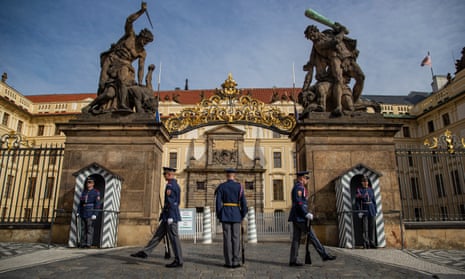The Czech Republic’s coalition government is on a collision course with the country’s populist president after it vowed to end controversial security arrangements at Prague’s historic castle, established supposedly to prevent terror attacks.
Vít Rakušan, the interior minister, said he would ask police and security services to review measures in place at the 70,000 sq metre complex, which is the country’s most visited tourist attraction and also the official residence of the Czech president, Miloš Zeman.
Writing on Twitter, Rakušan, a member of the liberal Mayors and Independents party (Stan), decried the metal detectors and armed officers guarding the castle’s four entrances as a “war fortification” that marred its status as a revered emblem of national identity.
“Prague castle is a symbol of Czech statehood,” he tweeted. “It belongs to all of us. And we are not really all terrorists, as we may now feel when we visit it. I have asked the relevant institutions to review all the security measures that have created a war fortification around the castle.”
Rakušan told Czech journalists the police would seek the opinions of all relevant bodies. “They will assess and comment on the necessity of the existing measures and possibly work on a new security regime,” he added. “I believe an assessment of the current massive measures is in order.”
The stringent regime – requiring visitors to empty their pockets and put their possessions on a conveyor belt – was fiercely criticised when it was introduced in 2016 after Islamist attacks in Paris and Brussels. The checks caused long queues at the castle gates, with guides complaining that they increased the time and cost of organised tours.
Critics insisted the castle’s status as public property rendered such measures inappropriate, while doubting the credibility of an Islamist threat in a country with a small Muslim population.
Some claimed the steps were prompted less by fear of terrorism than anger over a stunt carried out in 2015 by anti-Zeman activists, who managed to access the castle roof and fly a pair of large red boxer shorts in protest at the president’s vocal support for authoritarian regimes in Russia and China.
Zeman’s office said the security measures had been implemented on police advice.
While there was no immediate response on Rakušan’s comments, Zeman is likely to resist any change to the arrangements. His office accused two MPs from the interior minister’s party of “spreading misinformation” last month when they wrote an open letter to him calling for the security regimen to be lifted.
Zeman, whose term ends in 2023, has spent little time at the castle recently. He was admitted to Prague’s central military hospital with an undisclosed illness the day after a parliamentary election last October and spent 46 days there before being taken to the official presidential countryside retreat in central Bohemia, where he has been recuperating.
The last official occupant of the castle to be attacked was Reinhard Heydrich, who was head of the Nazi occupation administration running Bohemia and Moravia during the second world war. He was ambushed by British-trained Czechoslovak resistance fighters in 1942 and later died of his injuries. Heydrich did not live in the castle because he feared it was an easy target but was travelling there in an open-topped car when he was attacked.
The castle is thought to date back to 870 when its first walled building was constructed. It was later the seat of ancient Bohemian kings and the Holy Roman emperor. Adolf Hitler spent a night there after Nazi Germany invaded Czechoslovakia in March 1939.
